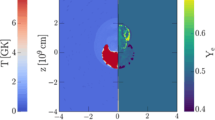Abstract
It is argued that the iron nucleosynthesis rate in the universe due to SNI outbursts is dependent on the mass function of star formation. Since the mass function depends on the chemical composition and since the masses of SNI precursors have upper limits, the iron nucleosynthesis rate was low at an earlier evolutionary epoch of the universe when mainly massive stars were formed. The iron nucleosynthesis rate should reach a maximum near z ∼ 0.5. At such or similar value of z the well-known ‘step’ in the cosmic γ-ray background spectrum may be explained by the presence of γ-gray quanta accompanying the radioactive56Co →56Fe decay. An argument is presented against the identification of the hidden mass of the universe with black-hole remnants of ‘type III’ stars.
Similar content being viewed by others
References
Bond, J., Carr, B., Arnett, D. 1983,Nature,304, 514.
Canizares, C., Clark, G., Jernigan, I., Markert, T. 1982,Astrophys. J.,262, 33.
Clayton, D., Silk, J. 1969,Astrophys. J.,158, L43.
Colgate, S. A., McKee, C. 1969,Astrophys. J.,157, 623.
Kirshner, R. P., Oke, J. B. 1975,Astrophys. J.,200, 574.
Matsumoto, T., Akiba, M., Murakami, T. 1983,Preprint, Nagoya Univ.
Maza, J., van den Bergh, S. 1976,Astrophys. J.,204, 519.
Meyerott, R. 1980,Astrophys. J.,239, 257.
Paczynski, B. 1970,Acta Astr.,20, 47.
Peimbert, M. 1973,Mém. Soc. R. Sci. Liége 6th Ser.,65, 227.
Ramaty, R., Lingenfelter, R. E. 1982a,A. Rev. nucl. part. Sci.,32, 235.
Ramaty, R., Lingenfelter, R. E. 1982b,Space Sci. Rev.,36, 305.
Shklovskii, I. S. 1981,Sov. Astr.,25, 578.
Shklovskii, I. S. 1983a,Nature,304, 513.
Shklovskii, I. S. 1983b,Sov. Astr. Lett., in press.
Sneden, C., Lambert, D. L., Whitaker, R. W. 1979,Astrophys. J.,234, 964.
Stecher, T., Maran, S., Gull, T., Aller, L., Savedoff, M. 1982Astrophys. J.,262, L41.
Terlevich, R., Melnick, J. 1983,Preprint, ESO No. 264.
Wu, C-ch., Leventhal, M., Sarazin, C., Gull, Th. 1983,Astrophys. J.,269, L5.
Author information
Authors and Affiliations
Rights and permissions
About this article
Cite this article
Shklovskii, I.S. Type I supernovae and iron nucleosynthesis in the universe. J. Astrophys. Astr. 5, 13–18 (1984). https://doi.org/10.1007/BF02714968
Issue Date:
DOI: https://doi.org/10.1007/BF02714968




